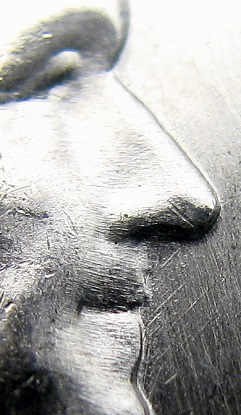
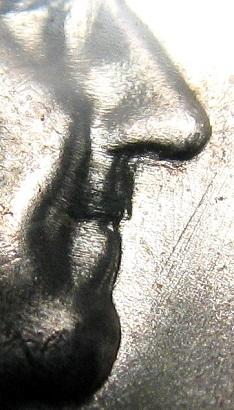
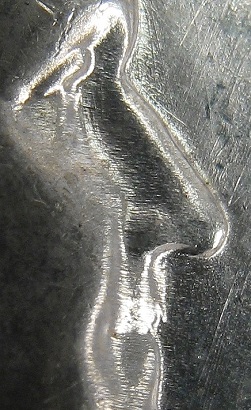
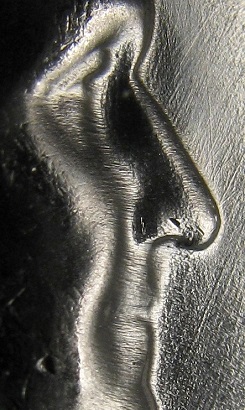
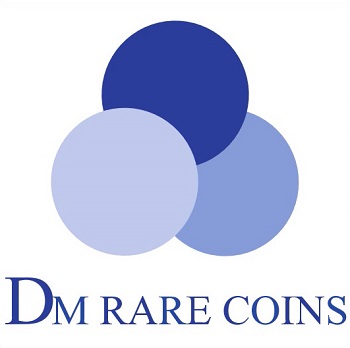 Franklin Variety Index, FVI Catalog
Franklin Variety Index, FVI Catalog
1948-1952, 1953-1955
The prime stage of this clash shows several spikes inside the mouth and on the lip, with the middle spike, near the tip of the lip, being the largest. The ridge of the nose, as well as the neck under the chin, have been re-engraved to remove clashing. Collar clash on neck. Tiny spike on bell, strong bulge under eagle, and extreme cap on right bell shoulder. This early stage shows fresh refinishing, trying to reduce clashing, leaving long, bright die scratches over both sides. Extremely scarce.
The bell lines are always weak on this variety; no examples of A-1 or its stages have been seen in FBL, indicating that the die was damaged by the clashing.
1956 FVI Bugs Bunny A-1a
Due to die erosion, the uppermost spike that forked the lip is gone, and the spike inside the mouth can be weak. Under the nose, a deep shelf has formed from clashing. While most of the plethora of die lines have now faded, several have become very prominent. Diagonal lines stretch from chin to nose. A very heavy line juts up from the top of the 5.
Evidence of re-engraving of the lower left bell lines now shows, indicating that the Mint was aware of the damage and tried to fix it. However, the bell lines still didn't strike up.
1956 FVI Bugs Bunny A-1b
On this most common stage, the largest spike is all that remains on the lip. It is still sharpand resembles a mustache.
1956 FVI Bugs Bunny A-1c
This is a diminished stage of the variety, but we list it for two reasons; first to differentiate it from the more desirable stages. And second, because a die break is opening up below the chin, threatening to chip out and create a goiter break, as seen on 1958-D and 1959 (P). Spike must still show some separation from the lip in order to qualify as A-1c. Later stages are too heavily eroded to be of interest.
The short base of an L-shaped clash, turned horizontally, butts up against the lip near the corner, while the long stand runs along the base of the nose, leaving a heavy bulge of raised metal between it and the nose. Faint arches along the way delineate the individual tips of the wing feathers. Positioned much further north and east than A-1, though the horizontal line under nose is similar to A-1a at a glance. A pronounced lump on bridge of nose where a large spike was filed down. Only a very slight collar clash. The E in LIBERTY is filled with die chips on all stages of this variety. Strong triangular spike just above bell lines. Thin bulge very close under eagle's wing, and bulging in field above right bell shoulder instead of a cap on bell. Hair line shows boldly through M of EPU. Lower right bell line has been re-engraved after evidence of Franklin's forehead below bell was removed. As with A-1, the dies have been freshly refinished. Both sides are covered with a canvas pattern of long, cross-crossing die lines creating a gleaming, semi-PL appearance. Visually stunning. Bell lines almost always well-struck on this die marriage. Very rare stage.
This is a somewhat remarkable die pair for the series. It shows up in three separate variety categories of the FVI: DDO, Bugs Bunny, and Die Chip. The obverse die is a dramatic Doubled Die Obverse that shows extreme extra thickness on all lettering, and up to four separate serifs on some numbers and letters, in earlier stages. Additionally, at the point in time when the die clash occurred, dramatic die chips had already filled the E in LIBERTY. Importantly, while all examples of this die clash show a filled E, not all pieces with a filled E show die clashing.
1956 FVI Bugs Bunny B-1a
Clash marks temporarily become even more bold as the dies begin to change to satin and frost. Many of the die scratches have diminish, but a horizontal line above date and a long, heavy line paralleling the nose begin to stand out from the rest. The spike from right bell remains bold, along with hair line through EPU. A very dramatic and somewhat scarcer stage than the following.
1956 FVI Bugs Bunny B-1b
Erosion has caused the clash to blend and recede away from the lip on this diminished stage. Some may be very weak. Virtually all die lines are gone, save for the two diagnostic lines that emerged in B-1a, though they too may become indistinct in places. This is the most common stage. A large number of coins must have been struck from this point forward, and the dies were over-used, though most still show at least a faint clash under nose. Mint set toning can obscure the weaker examples. Clashing must show clearly in order to qualify as B-1b.
1957 FVI Bugs Bunny B-1
1957-D FVI Bugs Bunny B-1
Two long, sharp spikes, one from upper half of lip, one from center of nose. Reminiscent of 1949 A-2, but no clashing appears in mouth (hence the B position). For reasons unknown, D-mint clashes are rarely seen in Position B, so this is a series enigma. Evidence of re-engraving along nose. Small collar clash. Strong triangular spike on bell wall, no discernible bulge under eagle, but clear cap on bell shoulder. Several long and extremely heavy die scratches in left obverse between IN and shoulder.
1957-D FVI Bugs Bunny D-1
The die pair also known as RPM-1 developed a strong, slanting clash line under nose in later stages. Fuzzy Distortion at base of neck. Long squiggly die line loosely follows neck all the way to chin.
1957-D FVI Bugs Bunny D-2 obv die change
The dies clashed again creating a new line to the left of the first. However, the first clash was already polished away by extensive refinishing, which left extremely heavy die lines. Eye socket polished open, and then closed by a hand re-engraving line. Heavy die polishing lines on and above nostril. Clear collar now shows on neck, and the squiggly die line has been polished away. Two very heavy, parallel die scratches run from T in Trust almost to Y in LIBERTY. A die chip has now connected the tip of the bust with the R in TRUST, confirming this to be the end-stage. Bell wall partly re-engraved at and above bell lines. Small cap on bell shoulder. RPM still very clear.
1957-D FVI Bugs Bunny D-3
The die variety also known as RPM-2 developed a strong, cylindrical clash line under nose shortly after issue (none have yet been documented without the clash). While similar in appearance to D-1a, there are distinct differences. The clash is heavier and the eye socket has not been polished away. Slight crease in upper half of nose. Slight collar clash. A round die lump shows on Franklin's lapel, like a flower. Extensive polishing lines over the obverse. Heavy triangular spike on bell wall and heavy hair line clash through EPU. Very few reverse die scratches.
1957-D FVI Bugs BunnyD-4
small line,long reverse die line
1957-D FVI Bugs Bunny D-5
weak nose line
1958 FVI Bugs Bunny D-1
there is a 1958 B-1
1958 FVI Type II ReverseBugs Bunny D-1
1958-D FVI Bugs Bunny D-1
1959 FVI Bugs Bunny B-1
STRONG, with outline clash
1959 FVI Bugs Bunny B-1a
fainter
1959 FVI Bugs Bunny B-2
1959 FVI Type II Reverse Bugs Bunny A-1
eds, fine polishing, re-engraved chin.
1959 FVI Type II Reverse Bugs Bunny A-1a
polishing and chin re-engraving indistinct
1959 1959 FVI Type II Reverse Bugs Bunny D-1
the blob
1959 FVI Type I/TypeII Bugs Bunny & DDR
This variety should exist, but we have not found one! The DDR reverse die for 1959 is found with a heavy profile clash of Franklin's nose, lip, and neck (see the "a" stage below). The obverse die was quickly changed out, presumably due to the extreme clashing that must have existed on the obverse. This could be a major Bugs Bunny variety. Help us find one!
1959 FVI Type I/Type II Bugs Bunny & DDR (a)
Not technically a Bugs Bunny anymore, as the clashed obverse has now been replaced with a brand new die, with gleaming, orange peel textured, borderline Prooflike reflectivity. The reverse die has been heavily polished and possibly acid etched, in an attempt to remove clashing, and yet it still shows a strong profile clash of Franklin on the reverse. This die marriage is of extreme interest to the specialist because of the Prooflike luster, profile clash, and the DDR.